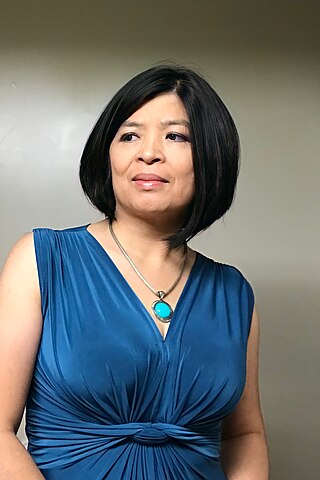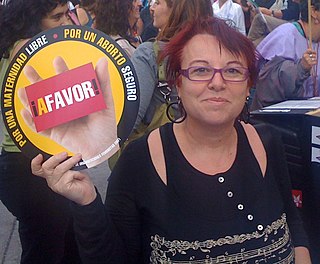Alternative media are media sources that differ from established or dominant types of media in terms of their content, production, or distribution. Sometimes the term independent media is used as a synonym, indicating independence from large media corporations, but this term is also used to indicate media enjoying freedom of the press and independence from government control. Alternative media does not refer to a specific format and may be inclusive of print, audio, film/video, online/digital and street art, among others. Some examples include the counter-culture zines of the 1960s, ethnic and indigenous media such as the First People's television network in Canada, and more recently online open publishing journalism sites such as Indymedia.

"A Cyborg Manifesto" is an essay written by Donna Haraway and published in 1985 in the Socialist Review (US). In it, the concept of the cyborg represents a rejection of rigid boundaries, notably those separating "human" from "animal" and "human" from "machine." Haraway writes: "The cyborg does not dream of community on the model of the organic family, this time without the oedipal project. The cyborg would not recognize the Garden of Eden; it is not made of mud and cannot dream of returning to dust."

Shulamith Bath Shmuel Ben Ari Firestone was a Canadian-American radical feminist writer and activist. Firestone was a central figure in the early development of radical feminism and second-wave feminism and a founding member of three radical-feminist groups: New York Radical Women, Redstockings, and New York Radical Feminists. Within these radical movements, Firestone became known as "the firebrand" and "the fireball" for the fervor and passion she expressed towards the cause. Firestone participated in activism such as speaking out at The National Conference for New Politics in Chicago. Also while a member of various feminist groups she participated in actions including picketing a Miss America Contest, organizing a mock funeral for womanhood known as "The Burial of Traditional Womanhood", protesting sexual harassment at Madison Square Garden, organizing abortion speak outs, and disrupting abortion legislation meetings.

Intersectionality is an analytical framework for understanding how individuals' various social and political identities result in unique combinations of discrimination and privilege. Intersectionality identifies multiple factors of advantage and disadvantage. Examples of these factors include gender, caste, sex, race, ethnicity, class, sexuality, religion, disability, weight, and physical appearance. These intersecting and overlapping social identities may be both empowering and oppressing. However, little good-quality quantitative research has been done to support or undermine the theory of intersectionality.
Cyberfeminism is a feminist approach which foregrounds the relationship between cyberspace, the Internet, and technology. It can be used to refer to a philosophy, methodology or community. The term was coined in the early 1990s to describe the work of feminists interested in theorizing, critiquing, exploring and re-making the Internet, cyberspace and new-media technologies in general. The foundational catalyst for the formation of cyberfeminist thought is attributed to Donna Haraway's "A Cyborg Manifesto", third wave feminism, post-structuralist feminism, riot grrrl culture and the feminist critique of the alleged erasure of women within discussions of technology.

Merlyna Lim is a scholar studying ICT, particularly on the socio-political shaping of new media in non-Western contexts. She has been appointed a Canada Research Chair in Digital Media and Global Network Society in the School of Journalism and Communication Carleton University. Formerly she was a visiting research scholar at Princeton University's Center for Information Technology Policy and a distinguished scholar of technology and public engagement of the School of Social Transformation Justice and Social Inquiry Program and the Consortium for Science, Policy and Outcomes at Arizona State University. She previously held a networked public research associate position at the Annenberg Center for Communication at the University of Southern California, Los Angeles. She received her PhD, with distinction, from University of Twente in Enschede, Netherlands, with a dissertation entitled @rchipelago Online: The Internet and Political Activism in Indonesia.

Mary Flanagan is an American artist, author, educator, and designer. She pioneered the field of game research with her ideas on critical play and has written several books. She is the founding director of the research laboratory and design studio Tiltfactor Lab and the CEO of the board game company Resonym. Flanagan's work as an artist has been shown around the world and won the Award of Distinction at Prix Ars Electronica in 2018.
VNS Matrix was an artist collective founded in Adelaide, Australia, in 1991, by Josephine Starrs, Julianne Pierce, Francesca da Rimini and Virginia Barratt. Their work included installations, events, and posters distributed through the Internet, magazines, and billboards. Taking their point of departure in a sexualised and socially provocative relationship between women and technology the works subversively questioned discourses of domination and control in the expanding cyber space. They are credited as being amongst the first artists to use the term cyberfeminism to describe their practice.

Cornelia Sollfrank is a German digital artist, she was an early pioneer of Net Art and Cyberfeminism in the 1990s.
subRosa is a cyberfeminist organization led by artists Faith Wilding and Hyla Willis.
Feminist Digital Humanities is a more recent development in the field of Digital Humanities, a project incorporating digital and computational methods as part of its research methodology. Feminist Digital Humanities has risen partly because of recent criticism of the propensity of Digital Humanities to further patriarchal or hegemonic discourses in the Academy. Women are rapidly dominating social media in order to educate people about feminist growth and contributions. Research proves the rapid growth of Feminist Digital Humanities started during the post-feminism era around from the 1980s to 1990s. Such feminists’ works provides examples through the text technology, social conditions of literature and rhetorical analysis. Feminist Digital Humanities is aimed to identify and explore women's sense of writing as well as to prove widespread of women's work in most of the digital archive.
Susanna Paasonen is a Finnish feminist scholar. She is a Professor of Media Studies at the University of Turku, and was a visiting scholar at MIT in 2016. She gained her PhD from the University of Turku in 2002; her dissertation was on gender and the popularization of the internet, which was later published through Peter Lang. After holding positions at the universities of Tampere, Jyväskylä and Helsinki, Paasonen was appointed Professor of Media Studies at the University of Turku on 1 August 2011, and publishes on internet research, media theory, sexuality, pornography and affect.
Julianne Pierce is an Australian new media artist, curator, art critic, writer, and arts administrator. She was a member of the groundbreaking group VNS Matrix. She went on to become a founding member of the Old Boys Network, another important cyberfeminist organisation. She has served as executive director of the Australian Dance Theatre and is Chair of the Emerging and Experimental Arts Strategy Panel for the Australia Council. Pierce was executive director of the Australian Network for Art and Technology (ANAT) from 2000 to 2005, based in Adelaide, and was Executive Producer of Blast Theory from 2007 to 2012, based in Brighton in the UK.

For the American jurist, see Nancy Paterson.
Lana F. Rakow is a professor emerita of communication at the University of North Dakota and author of Gender on the Line: Women, the Telephone, and Community Life (1992). In 2000, she was identified as a top woman scholar in journalism and mass communication, and her research results were reported by the Association for Education in Journalism and Mass Communication on the Status of Women. She also has numerous other published works that are primarily in the fields of communication and feminist theory.

Jennifer Radloff is a South African feminist activist and a pioneer on Information and communications technology (ICT) for social justice. She works for the Association for Progressive Communications (APC) in the Women's Rights Programme and is a board member of Women's Net.

Montserrat Boix Piqué is a Spanish journalist, considered among the most influential women in her country. In early 2000, she created and developed the concepts of social cyberfeminism, and a year later those of feminist hacktivism. Another of her main areas of work is gender violence and communication. She has also stood out as a defender of the right to communication and citizenship rights for women. Since 1986, she has been a journalist for the Information Services of Televisión Española (TVE), in the international section.
Prema Murthy is an American, multi-disciplinary artist based in New York. Employing aesthetics, gesture, geometry and algorithmic processes, Murthy's work explores the boundaries between embodiment and abstraction, while engaging in issues of culture and politics. Her work has been exhibited nationally and internationally at MoMA PS1, the Whitney Museum of American Art, the New Museum of Contemporary Art, the Reina Sofia Museum, the Generali Foundation in Vienna, and the India Habitat Center-New Delhi.
Evelyn Blackwood is an American anthropologist whose research focuses on gender, sexuality, identity, and kinship. She was awarded the Ruth Benedict Prize in 1999, 2007 and 2011. Blackwood is an emerita professor of anthropology at Purdue University.
Kishonna L. Gray is an American communication and gender studies researcher based at the University of Kentucky College of Arts and Sciences. Gray is best known for her research on technology, gaming, race, and gender. As an expert in Women's and Communication Studies, she has written several articles for publications such as the New York Times. In the academic year 2016–2017, she was a Visiting Assistant Professor in the Martin Luther King, Jr. Visiting Professors and Scholars Program at the Massachusetts Institute of Technology, hosted by the Department of Women's and Gender Studies and the MIT Comparative Media Studies/Writing Program. She has also been a faculty visitor at the Berkman Klein Center for Internet & Society at Harvard University and at Microsoft Research.








